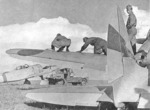Ki-27
| Country | Japan |
| Manufacturer | Nakajima Aircraft Company |
| Primary Role | Fighter |
| Maiden Flight | 15 October 1936 |
Contributor: C. Peter Chen
ww2dbaseThe Ki-27 Army Type 97 Fighters were the Japanese Army's first monoplane fighters, replacing the venerable biplane Ki-10 Type 95 Fighters produced by Kawasaki. Yasushi Koyama was the chief engineer behind the design. They performed superbly in the war on continental Asia, particularly at the Battle of Khalkhin Gol where Soviet fighters were helpless against the maneuverability of the Ki-27 fighters; the Soviets scored a few victories largely due to the Ki-27 aircraft's shortcomings in armor. Ki-27 aircraft were superseded by the Ki-43 design, but remained in service as bomber escorts during the opening stages of the Pacific War. Shortly after, they were slowly transferred away from the front lines, relegated to rear area patrol and training duties. Combining production numbers by Nakajima and Tachikawa, a total of 3,368 Ki-27s were built in Japan. A small number of them were built by the Manshu Aircraft Company in the Japanese-sponsored puppet state of Manchukuo in northeastern China, all of which were designated Ki-79 and were all in the configuration of trainers.
ww2dbaseThe Allied code name for the Ki-27 design was Nate.
ww2dbaseSource: Wikipedia.
Last Major Revision: Oct 2006
SPECIFICATIONS
Ki-27a
| Machinery | One Nakajima Ha-1 Otsu air-cooled radial engine rated at 650hp |
| Armament | 2x7.7mm Type 89 machine guns |
| Crew | 1 |
| Span | 11.31 m |
| Length | 7.53 m |
| Height | 3.35 m |
| Wing Area | 18.61 m² |
| Weight, Empty | 1,174 kg |
| Weight, Loaded | 1,598 kg |
| Weight, Maximum | 1,790 kg |
| Speed, Maximum | 444 km/h |
| Speed, Cruising | 350 km/h |
| Rate of Climb | 15.30 m/s |
| Service Ceiling | 10,040 m |
| Range, Normal | 630 km |
Photographs
 |  |  |  |
Did you enjoy this article or find this article helpful? If so, please consider supporting us on Patreon. Even $1 per month will go a long way! Thank you. Share this article with your friends: Stay updated with WW2DB: |
Visitor Submitted Comments
All visitor submitted comments are opinions of those making the submissions and do not reflect views of WW2DB.
- » WW2DB's 20th Anniversary (29 Dec 2024)
- » Wreck of USS Edsall Found (14 Nov 2024)
- » Autumn 2024 Fundraiser (7 Nov 2024)
- » Nobel Peace Prize for the Atomic Bomb Survivors Organization (11 Oct 2024)
- » See all news
- » 1,150 biographies
- » 337 events
- » 44,024 timeline entries
- » 1,242 ships
- » 350 aircraft models
- » 207 vehicle models
- » 375 weapon models
- » 123 historical documents
- » 260 facilities
- » 470 book reviews
- » 28,597 photos
- » 432 maps
George Patton, 31 May 1944
Please consider supporting us on Patreon. Even $1 a month will go a long way. Thank you!
Or, please support us by purchasing some WW2DB merchandise at TeeSpring, Thank you!
23 Jul 2022 01:58:17 AM
"particularly at the Battle of Khalkhin Gol where Soviet fighters were helpless against the maneuverability of the Ki-27 fighters"
lack of combat experience and correct tactics were main reasons of Soviet defeat at early stage of Nomonhan air war. Another factor were outdated I-15bis biplanes which can't hold against superior Ki-27. I-16 type 10 could (and did) fight on par
"the Soviets scored a few victories largely due to the Ki-27 aircraft's shortcomings in armor"
Soviets depleted Ki-27 Sentais in such degree that Japanese pulled to Nomonhan about all fighters they had, including obsolete Ki-10s. Total score of Ki-27 lost in Nomonhan air combat ONLY was 66. And you name it "a few"???